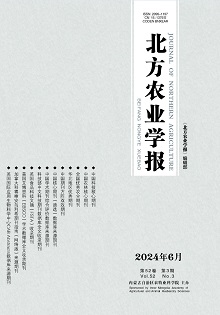Select
Creation and application of new cotton varieties with early maturity,high yield,good fibre quality,high adversity resistance and suitability for mechanization
WU Liqiang, WANG Xingfen, ZHANG Yan, KE Huifeng, LIU Sujuan, LI Zhikun, XU Dongyong, YANG Jun, SUN Zhengwen, GU Qishen, CHEN Bin, WANG Hongzhe, LU Huaiyu, ZHANG Guiyin, MA Zhiying
Journal of Northern Agriculture
2023, 51 (6 ):
1-9.
DOI: 10.12190/j.issn.2096-1197.2023.06.01
In response to the urgent demand for mechanization,lightened and simplified cotton production management,as well as the breeding difficulties of collaborative improvement and enhancement of plant architecture,early maturity,yield,fibre quality,and disease resistance for cotton varieties,research on new variety development with the early maturity,high yield,good fibre quality and suitability for mechanization and coordinative cultivation techniques were carried out. Breeding technologies of synchronous improvement of early maturity,density resistance,lodging resistance and suitability for mechanization were established with “two modifications,two increases,and four selections”. Ten elite breeding parent materials were produced. A total of 633 SNP loci associated with 14 traits were determined,including flowering period,Verticillium wilt resistance,boll weight,lint percentage,fibre length,fibre strength and so on. Twenty-six KASP markers with lower cost and higher throughput were developed for breeding selection of fibre quality and Verticillium wilt resistance. Twelve key genes regulating early maturity,fibre quality,adversity resistance and seed germination were discovered. And their expression patterns in different varieties were documented. Using the elite breeding parent materials,breeding techniques,and developed molecular markers,four new varieties including Jinongda 23,Jinongdamian 24,Jinongdamian 25 and Jinongda 36 were bred with early maturity,high yield,good fibre quality and suitability for mechanization. New breakthroughs were made in improving mechanical characteristics such as compact plant architecture,early maturity,concentrated boll opening,and synergistic enhancement with high yield,good fibre quality and disease resistance. Simple,labor saving,and efficient supporting techniques with “one-hole-one-seed machinery sowing,expanding the number of bolls in the population,chemical regulation in whole growing season and pruning-free,and concentrated harvesting in cotton fields” were created for mechanical harvesting. By combining science,enterprises and application,demonstration bases with strong representatives,wide coverage,and strong driving force were established,leading the large-scale production and application of new varieties,with an income increase of 2 700-3 000 yuan per hectare and 60-75 labor saving,significantly reducing costs and increase efficiency.
Reference |
Related Articles |
Metrics



